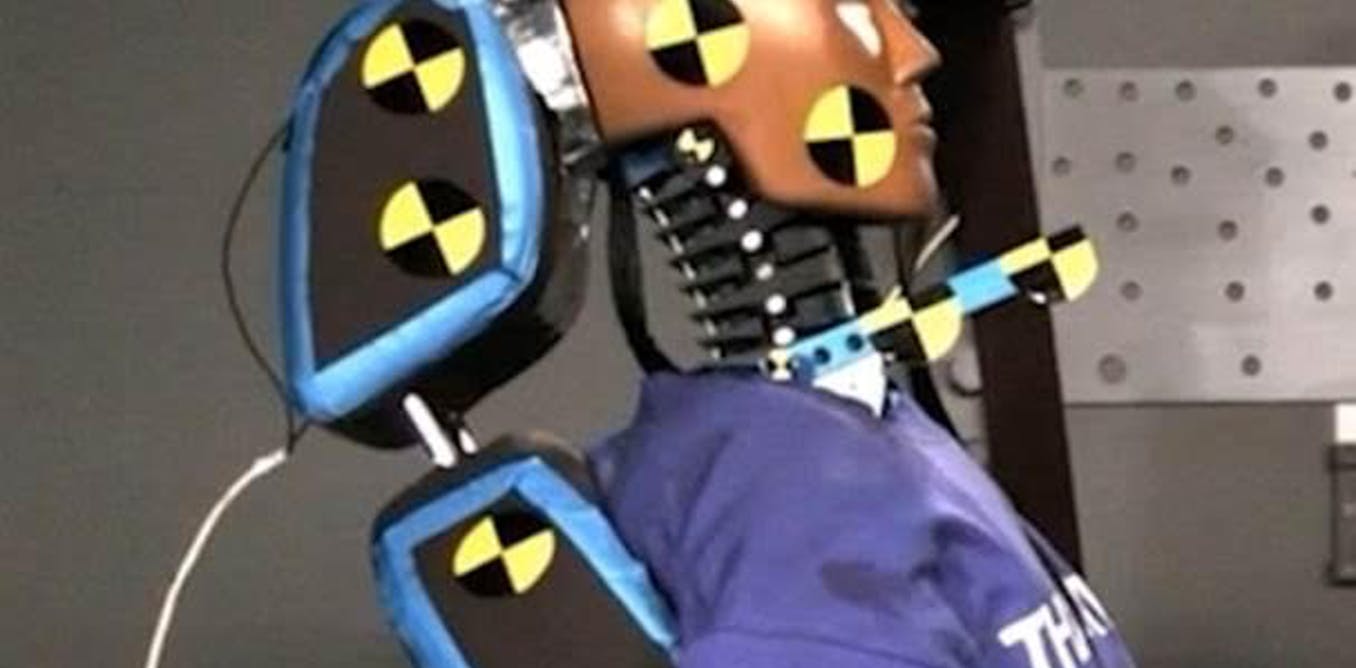How to reduce the risk of whiplash in car accidents

Who's driving? Thatcham, Author provided
The UK has been called the “whiplash capital of Europe” after insurance giant Aviva revealed that the number of whiplash injuries reported in 2015 was predicted to top 840,000, up 9.7% on the previous year. This, said Aviva, had forced car insurance premiums up by an average of £93.
Whiplash most often occurs as a result of rear-end collisions of vehicles, often at low speeds – typically less than 25km/h. Whiplash is a disorder of the soft tissues of the neck caused by a sudden differential movement between the head and torso, straining the soft tissue of the neck, such as muscles and ligaments, beyond their normal range of motion.
In a rear-end collision, the head and torso of a car driver or passenger move backwards relative to the seat. The torso is supported by the seat back, so its movement is limited. But the head sharply rotates backwards with respect to the torso until it is stopped by the head restraint. This causes a hyperextension of the neck creating a “whiplash” effect. Finally, the head rotates forward and the torso rebounds. All this happens typically within 125 milliseconds, causing a whiplash disorder in the occupant’s cervical spine.
Although whiplash is officially classed as a minor injury, symptoms can last for a long time, affecting not only the nation’s health but also impacting on the economy. This is why it is important to limit the risk of whiplash injury.
Whiplash can be reduced by limiting the distance between the head and the head restraint, often referred to as “backset”. The ideal distance should be zero, but this is neither practical nor comfortable for the occupant. Backsets more than about 10cm from the head have been associated with increased symptoms of neck injury in crashes.
 Fast-moving head restraint reduces chance of neck injuries. Animation by Rickie Bewsher, Loughborough University.
Fast-moving head restraint reduces chance of neck injuries. Animation by Rickie Bewsher, Loughborough University.
Reactive seats that move the head restraint closer to the head by the pressure of the torso in the event of a rear-end crash are known to reduce whiplash injuries which can also be alleviated by reducing the relative motion between the head and the torso and absorbing the impact energy. This relative motion is reduced by allowing the seat back to move backwards slightly and then to rotate backwards. During this process, a part of the seat mechanism is allowed to elastically deform to also absorb the impact energy. There are a range of seats and head restraints based on these concepts that are designed specifically to mitigate whiplash.
Designing for safety
We’ve been researching ways to combine these different whiplash-mitigating approaches in one integrated design and have come up with a concept which demonstrates how the head restraint and car seat can react simultaneously when the body of the occupant begins to push against the seat back during a rear-end collision.
 Seat adjusts to reduce movement of neck and torso. Animation by Rickie Bewsher, Loughborough University.
Seat adjusts to reduce movement of neck and torso. Animation by Rickie Bewsher, Loughborough University.
This is achieved by the proposed system comprising mechanical linkages built into the head restraint and the seat which allows the force of the occupant’s body not only to move the head restraint up and forward to close the gap between the head and head restraint but also simultaneously to push and tilt the seat backwards in a controlled manner to reduce the differential motion between the occupant’s head and torso.
The results from the simulation, based on a rigid human model positioned in driving posture, showed that the integration of a reactive head restraint and car seat would be very effective in reducing the occurrence of whiplash. These mechanisms are designed to be reactive – that is, they will only operate when the vehicle receives a rear-end collision. These mechanisms are designed to react instantly and simultaneously when the body of the occupant begins to push against the seat back. It should be noted that the reactive seat concept would require a damper to control the motion of the seat and absorb the energy of the occupant.
Our simulations show that the system is capable of moving the head restraint upwards and forwards quickly enough to prevent hyperextension of the neck occurring. Furthermore, the seat reclines, reducing the relative motion between the head and torso before the whiplash mechanism has time to have an effect.
The seat could also be fitted with an appropriate elastomeric damper to absorb impact energy further, reducing the effect on the occupant. Elastomeric dampers are small blocks of rubber-like material, designed to control the backwards movement of the seat, initially with softer reaction, allowing the seat to move backwards, and then with a stiffer response to slow down the seat movement and finally to stop the motion within a few centimetres.
The damper must react in the manner described above, which requires finding the optimum geometry combined with the right material combination. Currently, work is underway for developing elastomeric dampers to control the rearward motion of the seat and absorb impact energy.
A prototype of this integrated concept will be built for sled testing to verify the design. But we are optimistic that this will give car manufacturers an effective and economic way of reducing whiplash in rear-end collisions.

Memis Acar does not work for, consult, own shares in or receive funding from any company or organisation that would benefit from this article, and has disclosed no relevant affiliations beyond their academic appointment.







